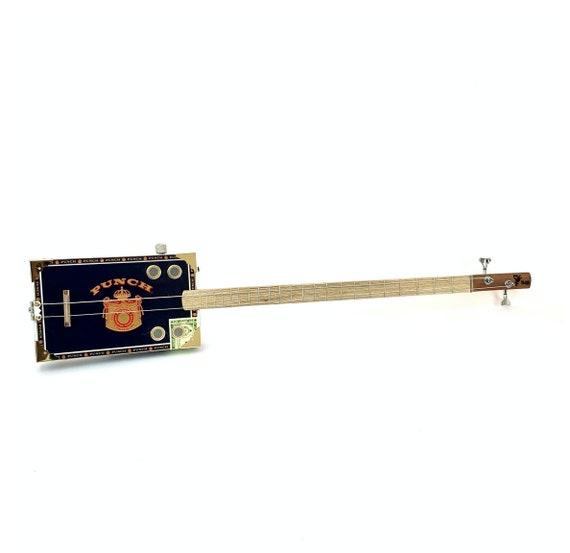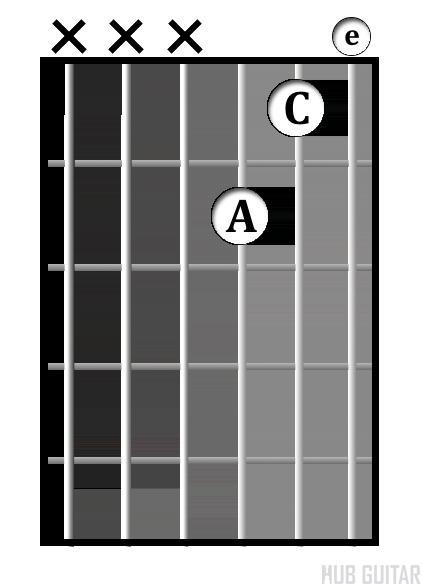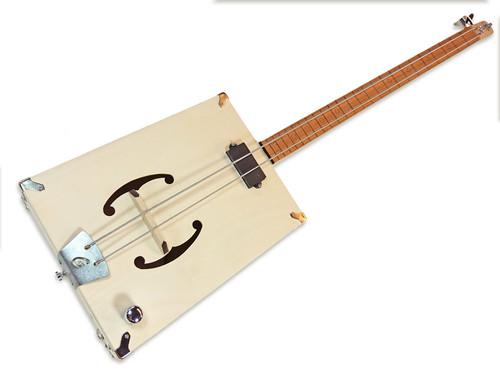Imagine performing a captivating solo on a guitar with just two strings, or creating your own 2-string instrument from scratch and seeing it come alive in your hands. That’s not a pipe dream, that’s the transformative journey of mastering the 2-string guitar. It changed my perception of music forever. What’s even more interesting? You’re about to embark on this same journey, and the destination is all but ordinary. Yet, the full scope of its profundity, you’ll have to discover as we go along.
As a lifelong guitarist and Berklee College of Music graduate, the world of two-string instruments holds a special place in my heart. The 2-string guitar, unconventional as it may seem, creates a realm of opportunity for artistic expression that goes beyond traditional musical norms. It’s like stepping into an alternate universe where minimalism meets creativity – a place where less really does mean more.
Through this comprehensive guide, you’ll not only learn to play skillfully on a 2-string guitar but also craft your own, becoming a creator as well as a performer. This dual experience will broaden your understanding of music, strengthen your skills, and take your appreciation for the 2-string guitar to a whole new level.
No need to guess or grope in the dark, I’ll be giving you expert advice, proven techniques, and invaluable tips accumulated from years of playing and crafting these amazing musical instruments. From understanding their origin and popularity to mastering the art of playing and crafting, this guide is your one-stop resource.
If you’re ready to diverge from the conventional path and set out on an exciting journey of musical discovery, then strap in, and let’s delve into the captivating world of 2-string guitars.
Understanding 2-String Guitars
Origin and Popularity

In my years of teaching and playing, one unique instrument I constantly came across was the 2-string guitar. Often, these were homemade guitars, customized as per the players’ needs. These beautifully simplistic instruments hold their own distinctive position in the music world.
This form of guitar finds its roots in the ingenious spirit of music lovers who possessed limited resources but infinite passion. Diverse cultures around the globe with distinct music styles variously popularized it. This humble origin provides the 2-string guitar its unique charm and appeal.
The popularity of the 2-string guitar is deeply connected to its personification of simplicity. The true power of a 2-string guitar lies in its ability to beautifully articulate melodic lines, even within its minimalistic framework. Over the past decades, it has significantly moved from being a marginal curio to a choice instrument of popular bands and well-established artists. This has led to the rise in its recognition, creating a surge in demand for these instruments.
Its journey from a makeshift instrument of necessity to being celebrated for its tonal unique-ness is truly intriguing and inspiring. It commands its place in our shared music heritage, both for its simplistic design and ripe versatility. They serve as perfect embodiments of how one can create acoustic magic through bare minimum yet inventive resources.
Remarkably, its popularity continues to grow, as more and more musicians discover the treasure trove of musical possibilities it provides. Truly, the 2-string guitar holds significant relevance to the inner workings of music itself, a testament to its human origin and sustained popularity. Next, we shall explore the diverse types these guitars have evolved into.
Types of 2-String Guitars

Over my years of teaching and immersing myself in the artistry of guitar playing, I have cultivated a specific interest in the subsets of 2-string guitars and their individualistic traits. Delving deep into their unique characteristics has not only enriched my understanding but also played a pivotal role in enhancing my overall technical abilities.
Firstly, let’s shed some light on the cigar box guitar, an intriguingly unconventional type of 2-string guitar known for its DIY charm. Born out of necessity during the Great Depression in America, these guitars were fashioned from discarded cigar boxes with strings attached – literally. Contemporary iterations have evolved into collectible handcrafted works of art. What I find most fascinating about this type is the vocal quality it produces; much of which is down to the hard, resonant qualities of the cigar box. With each strum, you can feel the guitar’s history and charm pulsating through the strings.
Next up on my list is the diddly bow, a primitive single or 2-string guitar with African roots. This instrument, commonly associated with blues music, has deep cultural and historical significance, and it’s still seen as the starting point for many guitar enthusiasts. It comprises a string, tensioned between two points and is played by striking the string while fretting it with a metal or glass slide. Its simplistic construction and intriguing sound profile have always captivated my attention.
Lastly, let’s touch upon the 2-string electric bass guitar. Generally used in Russian folk music, these guitars produce a deeper, resonant sound, perfect for delivering robust basslines. With only two strings to concentrate on, the player’s focus can be channelled completely into perfecting the rhythm and tone, leading to a well-rounded and nuanced understanding of bass techniques. In my personal experience, mastering this instrument had a direct impact on enhancing my rhythm guitar skills.
In the realm of 2-string guitars, these typologies offer a wonderfully diverse range of sounds, playing techniques, and histories. They challenge conventional guitar playing styles and open doors to unexplored genres and rhythms. They’ve been integral to my journey and have profoundly affected my approach to teaching and playing the guitar. Understanding them allows us to appreciate not just their individual contributions, but also the richness they bring to the overall fabric of guitar music.
As we progress in our exploration of the world of 2-string guitars, every aspect—from their origins and popularity to mastering playing techniques—each layer unfolds a trove of wisdom and inspiration. Up next, we focus on how to actually play these unique 2-string variants, ensuring you the ability to straddle genres, historical timelines, and cultures with just a couple of strings under your fingertips.
Playing 2-String Guitars
Tuning Techniques

Having explored the elements that define the 2-string guitar, it becomes crucial to shed light on an indispensable skill that is synonymous with the mastery of these unique instruments – guitar tuning. As a professional music critic, I recognize the fundamental role of correct tuning in shaping the tonal quality and playability of any guitar, not least the 2-string variant.
Tuning techniques for the 2-string guitar are distinct yet exciting, shaping the instrument to truly reflect its potential. Perhaps the first distinction lies in the process itself. Reduced strings necessitate a different approach, governed by increased focus on precision and string gauges for guitar tuning.
You’ll find that with the 2-string guitar, accuracy is paramount. The margin for error is significantly smaller, making it pivotal to give due attention to each string. This methodical precision, though a challenge, also carries the potential for discovery, making 2-string guitars a constant source of learning and fascination.
Understanding the effect of string gauges for guitar tuning is another fundamental aspect of mastering the 2-string guitar. The string gauge, in essence, determines the string’s tension and, therefore, its pitch. Thicker strings tend to produce deeper, louder tones, while lighter gauges lend themselves to higher, softer pitches. The beauty of the 2-string guitar lies in its flexibility here, allowing you to experiment and create a unique sound signature.
Mastering the process of tuning a 2-string guitar thus ignites the spark of creativity, granting the freedom to create music that transcends traditional boundaries. It’s a skill that, when honed, holds the secrets to unlocking the untapped, captivating universe of tones hidden within the instrument.
In my professional experience, mastering the art of tuning a 2-string guitar truly epitomizes the enthusiast’s journey, harmoniously linking knowledge, skill, and ingenuity. The experience is as enlightening as it’s rewarding, and carries the promise of tapping into the 2-string guitar’s unique tonal richness.
As we progress to the following section on playing techniques, it becomes evident that successful tuning techniques lay a solid foundation for effective playing. An accurately tuned guitar not only enhances the quality of sound produced but also significantly influences the ease of playing. Truly, mastering the art of 2-string guitar-playing is both an art and a craft, harmoniously interwoven, and nothing exemplifies this more aptly than the delicate yet transformative art of tuning. So, tune in and allow your 2-string guitar to sing its own unique symphony!
Playing Techniques

Delving into the heart of playing 2-string guitars, let’s explore some of the unique playing techniques that can significantly enhance your music practice. Whether it’s blues, contemporary, or slide, playing on a 2-string guitar offers a distinct thrill. It’s not just about mastering the notes but immersing in the rhythm and vibe that this unique instrument provides. Armed with patience and persistence, you will soon find your fingers adeptly creating melodic symphonies. Here are some of the guitar techniques I frequently use, conveying my years of expertise and discovery playing 2-string guitars.
Slide Guitar: One of the most expressive and nuanced techniques is playing slide guitar. This method typically involves a glass or metal tube, referred to as a slide. The slide is used over the strings, instead of your fingertips, to change the pitch of the notes. The resultant sound can convey a distinct bluesy, raw, and emotive tone often associated with Delta blues and traditional roots sound.
When I play blues on 2-string guitar, the key lies in the finesse of my slide technique. This technique can take a while to master, but the payoff is immense in terms of the range of emotion and sound you can evoke. As you practice, remember to keep the slide parallel to the frets, only pressing lightly on the strings to avoid unnecessary noise. You’ll soon discover that the slide method allows you to create music filled with deep emotion and resonance.
Picking and Strumming: With just two strings, the picking technique becomes a vital part of your playing style. Practice alternate picking, where you pick the strings in an up-down pattern, to increase speed and fluidity in your playing. Keep your wrist relaxed and your movements small and precise. This method is excellent for playing faster passages and maintaining a smooth rhythm.
Strumming on a 2-string guitar feels different from a standard guitar. It might seem limited at first, given the fewer strings, but I’ve found it offers a unique environment to focus on precise rhythm and tone control. It has helped me concentrate on the texture of my music, creating sounds that are raw, organic, and profoundly captivating.
Playing a 2-string guitar can at times feel like a dance — a disciplined, rhythmic movement that requires finesse, control, and creativity. This challenge, however, is the beauty of the 2-string guitar. It’s a remarkable instrument that captivates with its simplicity while demanding maturity and skill in technique.
The playing techniques I have discussed, slide and picking or strumming, are only the beginning. The journey of mastering the art of 2-string guitar, inherently demands a willingness to continually improve, adapt, and experiment. As you progress and immerse yourself in these techniques, you’ll begin to sense the inherent rhythm of the 2-string guitar – and that’s when this distinctive instrument truly starts to sing.
Developing your distinct style is a process, but hopefully, these techniques provide a solid starting point. In the forthcoming section, we will drift into the creative realm of building your own 2-string guitar, contributing further to this immersive experience. Stay tuned!
Building a 2-String Guitar
Choosing the Right Kit

As part of our journey in mastering the art of the 2-string guitar, let’s zero in on the crucial step of selecting the right kit for building our instrument. Choosing the right DIY guitar kit forms the backbone of our construction endeavor, embodying our guitar’s overall quality, playing capability, and aesthetic appeal.
In my journey of crafting guitars, the expertise and insights that I’ve amassed can help you maneuver this critical selection process. With centuries-old refinement embedded in their design, 2-string guitars are a marvel of craftsmanship and a joy to build and play. A good kit serves as your canvas, offering a harmonious blend of precision-engineered parts and unique customizable options.
When deciding to build a 2-string guitar, you should look for kits that offer high-quality wood for the body and neck, allowing for a richer, more resonant sound. The quality of the wood used will directly influence the depth and quality of your guitar’s tone, so it’s a factor that deserves your thorough attention.
Additionally, the availability of all necessary components—strings, tuning pegs, fret wire, bridge material, and instructions—should be noted. A well-made kit includes clear, detailed instructions and all requisite hardware, enabling you to piece together your guitar without unnecessary hurdles. The inclusion of some specialized tools, though not always present, is definitely a plus.
But while quality materials and components are non-negotiable, there is also a subtler facet to consider—the potential for customization. A good kit will provide a solid foundation for your 2-string guitar while leaving room for your personal touch. This could mean the potential to add ornamentation, experiment with different finishes, or the latitude to swap in high-grade components of your choice.
Remember, diving into the realm of guitar building is as much about expressing your creativity and honing your luthier skills as it is about the end product. Therefore, whether you are a budding guitarist or an experienced musician looking to expand your collection, a well-rounded kit enables you to build a quality 2-string guitar that resonates with your style.
As we move forward in our guitar-building journey, the art of customization takes center stage next. We will delve into how to personalize your hand-built 2-string guitar whilst providing a glimpse into different techniques, materials, and styles that can be utilized to create your bespoke instrument.
Customization Techniques

As we continue on our creative journey in guitar building, the time has come to imbibe a sense of individuality into your 2-string instrument. Delving into the realm of guitar customization lets you blend your personality into your guitar’s, thus creating a unique bond. How the guitar feels when you play, and how it sounds to your ears, can have a distinctive stamp that resonates with your musical sensibilities.
From my experience, personalizing a guitar is a rewarding encounter that allows us to interact with our instrument beyond a mere playing experience. I’ve found incredible joy in shaping my guitars to mimic my preferences and styles. Now, I’ll share some top tips on how to achieve this exclusive connection with your 2-string guitar.
Primarily, consider the choice of wood. Its aesthetic appeal and acoustic properties mold the overall tonality and look of the guitar. I suggested in our prior section to choose a kit tailored to your abilities, and a key part of that decision is the guitar’s body wood. Consider a softer wood, like Basswood or Mahogany, if you’re after a warmer tone. Harder woods like Ash and Maple bring about brighter tonalities.
Moving onwards, the finish on your 2-string guitar can be a crucial point of customization. From glossy lacquer to matte varnish, there’s an array of options to choose from. While maintaining the natural wood pattern, a straightforward oil or wax finish will get you closer to a classic style guitar. However, for a flashy, modern look, try a bold colored stain or paint.
The third aspect of customizing involves the hardware. Tuning pegs, bridges, and tailpieces all contribute to the ergonomics and playability of your guitar. A high-quality bridge or tailpiece does not just enhance stability and tuning; they can also improve your playing comfort. Do consider spending those extra bucks for greater quality parts.
Finally, do not underestimate the process of listening during the buildup. Your 2-string guitar might need delicate adjustments to genuinely sing. Whether it’s adjusting the action (string height), tweaking the intonation (notes in tune along the fretboard), or fine-tuning the pickup height, your ears are the ultimate guide in personalizing your guitar.
Remember, customization is a personal journey. It is an exploration of your creativity beyond playing. It’s your chance to breathe life into the instrument and meld it to suit your musical expression. I hold my customizations close to my heart as they capture my TIME – Thought, Imagination, Mastery, and Expressiveness.
As we move deeper into our path of mastering the 2-string guitar, we will illuminate some frequently asked questions and conclude our journey into the world of this fascinating instrument.
FAQs
What is the concept behind “Mastering the Art of 2-String Guitar: A Comprehensive Guide to Playing and Crafting”?
Who can benefit from this guide?
Is it necessary to have prior knowledge of guitar playing before diving into this guide?
Does this guide include lessons on crafting your own 2-string guitar?
Conclusion
In wrapping up, the voyage of honing your artistry on the 2-string guitar can truly serve as a catalyst to propel your musical creativity. It throws you into an avenue to broaden your creative spectrum, discovering incredible string guitar songs while recreating your approach towards guitar music. Drawing from my trove of experiences, I earnestly affirm that playing and crafting a 2-string guitar offers an exhilarating opportunity to go beyond your creative borders.
Moreover, remember this: the journey into music, be it exploring the 2-string guitar or any other instrument, ought to be a joyful expedition. A journey wired with constant discovery and imbued with the charm of ceaseless learning. After all, isn’t the key to mastering any craft rooted in passion and lifelong learning?
What if I told you the journey of mastering the 2-string guitar could revolutionize your musical creativity? The allure of this simple yet powerful instrument broadens the horizon of your musical abilities, challenging you to weave beautiful melodies from just two strings. Unveil the unexplored, craft your unique style, and let your creativity echo through the strum of a 2-string guitar.
In closing, the 2-string guitar is more than just another instrument; it’s a distinctive medium that allows musicians to reinterpret their creativity in innovative ways. So, take up the challenge today, and watch your artistry take flight in ways you never imagined.
